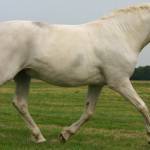Consider Trotting Speed when Diagnosing Lameness

Veterinarians called to examine a lame horse almost always ask that the horse be led in a straight line at a trot as part of the examination. If the horse nods or bobs its head slightly when a lame leg bears weight, the regularity of the two-beat trot is interrupted, making it easier to figure out which leg is being favored. Even without the telltale head bob, a veterinarian watching a trotting horse can often note the awkward use of a shoulder or a slightly shorter stride with one hind leg. Finally, lameness can sometimes be detected by listening to the regularity of hoofbeats as the horse trots on a hard surface.
For the best diagnostic use of trotting, it’s essential that the horse have free use of its head and neck while in motion. Now, researchers from the Department of Veterinary Clinical Sciences at the Royal Veterinary College in Hatfield, UK, have found another important fact: Making a slightly lame horse trot too fast may obscure clinical signs. A slower trot often allows the signs of mild discomfort to be seen most easily.
Ten horses, some sound and others with diagnosed mild lameness in front or hind legs, were used in a trial in which six experienced equine clinicians were asked to evaluate lameness. The horses were trotted at slow, normal, and fast speeds in both straight lines and circles. The horses were also fitted with sensors that indicated any asymmetry in their gaits.
When the horses were trotted on a straight line, lameness was seen less often in horses trotting at the fastest speed, but more often when a slow trot was performed. The sensors picked up asymmetric movement at all speeds. For horses trotting in circles, lameness was seen equally well regardless of speed. Interestingly, the sensors indicated more asymmetry for all the horses when they circled at a fast trot. This could relate to the fact that the horse’s outside legs must travel further than the inside legs while moving on a circle.
Even though the sensor-based lameness detection systems offer valuable information on a horse’s soundness, they should not completely replace visual assessment, according to the researchers. Results obtained from a sensor system can easily be skewed if sensor placement, measurement validation, and accurate data interpretation are not carried out. A visual examination also allows a practitioner to notice things like toe-dragging, muscle atrophy, or conformational faults that influence the way a horse moves. Probably the best way to evaluate lameness is to observe the horse trotting at different speeds on a straight and circular track, with input from asymmetry sensors if this technology is available.








